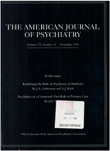Mind and mood in modern art, II: Depressive disorders, spirituality, and early deaths in the abstract expressionist artists of the New York School
Abstract
This article documents the high prevalence of mood disorders in a group of 15 of the mid-twentieth-century Abstract Expressionist artists of the New York School. These artists, using the technique of psychic automatism (based on free association) in order to reveal unconscious material, created a psychologically and spiritually significant art that addressed the mythic themes of creation, birth, life, and death. Over 50% of the 15 artists in this group had some form of psychopathology, predominantly mood disorders and preoccupation with death, often compounded by alcohol abuse. At least 40% sought treatment and 20% were hospitalized for psychiatric problems. Two committed suicide; two died in single-vehicle accidents while driving; and two others had fathers who killed themselves. Many of these artists died early deaths, and close to 50% of the group (seven of 15) were dead before the age of 60. The material presented in this article suggests the following formulation and hypothesis. Depression inevitably leads to a turning inward and to the painful reexamination of the purpose of living and the possibility of dying. Thus, by bringing the artist into direct and lonely confrontation with the ultimate existential question, whether to live or to die, depression may have put these artists in touch with the inexplicable mystery that lies at the heart of the "tragic and timeless" art that the Abstract Expressionists aspired to produce.
Access content
To read the fulltext, please use one of the options below to sign in or purchase access.- Personal login
- Institutional Login
- Sign in via OpenAthens
- Register for access
-
Please login/register if you wish to pair your device and check access availability.
Not a subscriber?
PsychiatryOnline subscription options offer access to the DSM-5 library, books, journals, CME, and patient resources. This all-in-one virtual library provides psychiatrists and mental health professionals with key resources for diagnosis, treatment, research, and professional development.
Need more help? PsychiatryOnline Customer Service may be reached by emailing [email protected] or by calling 800-368-5777 (in the U.S.) or 703-907-7322 (outside the U.S.).



